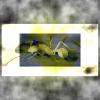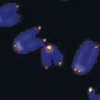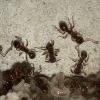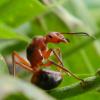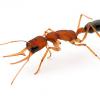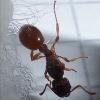Yeah not REALLY a hierarchy buuuut it's clear that typical workers are more expendable in terms of overall colony behavior. And the queen's pheromones do affect worker ants' reproductive systems.
Really, in a way, it'd be more accurate to call the queen a slavemaker. Her workers are forced into servitude if they want any hope of their genes surviving into the next generation. Ants do not have feelings. They don't understand the concept of one thing being better than the other. These are all human ideas that we project onto ants.
The reason that the queen's pheromones affect the worker ants is because colonies where the workers aren't affected didn't do as well and were selected out of the population. Likely because colony function disintegrates when the workers can spread their own genes directly. The workers did not choose to allow this, nor do they "see" it as some sort of class-system.
Ants and humans aren’t really alike at all.
Humans and ants’ last common ancestor was hundreds of millions of years ago.
We anthropomorphize their behaviors as “slavery” and “agriculture” (to use to ur examples) but these aren’t really that accurate. The latter, for example, is more a symbiotic relationship than true agriculture.
Couldn't our relationship with corn, in a broad sense, be considered symbiosis? I mean, first of all, compare the ancient "teosinte" with modern day corn. Corn wouldn't have become what it is now without human intervention. Second, corn gets protection and sustenance from us, and we obtain food from them. Sounds a lot like what Atta and Acromyrmex spp. do with their fungi.
The thing you're missing is that in the human-corn scenario, we controlled the corn and selected which traits were exaggerated or bred out of the population. In the ant-fungus scenario, the fungus has as much control over the ants as the ants do over the fungus. We look at it as humans and go "hurr durr that looks like when we farm corn." But really, the fungus has figured out a way to be perfectly cared for 24/7. All it has to do is allow the ants to eat some of itself that it created from the mass amounts of food the ants provide for it. If at any moment the fungus were to die, the ants would quickly follow suit. That is why it is symbiosis and not ant-agriculture.
...which is why I said it was in a broad sense. Of course some things are going to be different (in this case, origins), but nonetheless, these two relationships are strikingly similar. And besides, (again speaking in a broad generalization) over time, natural selection keeps selecting the better genes from the ant relative to the fungus and the fungus relative to the ant. Could not the corn, in a similar way, adapted such that it is cared for 24/7 (even with human engineering, we were bound to make a few mistakes, and the corn had to adapt relative to that)? Another thing is that the ant too has come up with a way to be perpetually fed, analogous (in the literary sense) once again to our use of corn. And referring to your remark on our control over corn, the ant's pure existence with the fungus guides the forces of natural selection (however, our control over corn is mostly volitional rather than natural) Even though we humans do indeed have more control over the corn's adaptations, the laws of nature still apply. Besides, whether or not the corn's adaptations are a result of natural selection or anthropogenic causes makes little difference as, speaking naturalistically, humans are still an element of nature.
I can already see this is a particularly touchy subject, but it is kind of an interesting one. Besides, regardless of the outcome, whatever is true is true and we should believe what is proven to be true, right? There's no shame in that.
Edited by TheMicroPlanet, December 27 2019 - 6:17 AM.





